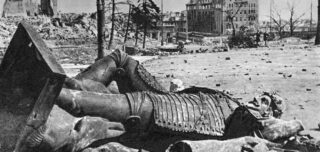Since the slaughter in Charlottesville by James Alex Fields Jr, of Vanguard America, a flurry of opinion has descended around the appropriate way to confront the various fascist organizations colluding and vying for institutional power. But however well intentioned, most of this commentary is poorly informed.
Rather than interrogating the motive force behind the far right, such debates largely fall along the lines of what the morally proper thing for an individual opposed to fascism ought to do.
Missing from much of this debate is why Richard Spencer’s coalition of Nazis was there in the first place. Spencer and his ilk had come to Charlottesville twice before their reprise on the 11th and 12th. In all three cases, they assembled by a statue of Robert E. Lee due to be removed by the city.
The fate of one statue will change little materially. What it provides, however, is justification
Richard Spencer talks endlessly about the erasure of white men from society. For this he refers both to civil rights programs guaranteeing equality of access to employment and housing options, and his perceived sense of social marginalization on this basis.
We’ll set aside for now that the real cause for his social marginalization is that he is an entitled, insufferable Nazi whom no one wants to be around. He knows full well that the fate of one statue will change little in regard to the material consequences of an egalitarian society, nor the social marginalization he sees as the result. What it does provide, however, is justification.
It is no hyperbole to call Spencer a fascist. He openly embraces their more obscure writers and adherents including Julius Evola, Alexander Dugin, and Oswald Spengler – while implicitly embracing more well known ones like Adolf Hitler and David Lane.
Mussolini’s regime marshaled Roman artifacts to justify fascism
Though centrists like to reassure themselves that fascists are all ignorant dolts, the leadership is fairly well-read in both fascist and non-fascist literature & political thought. Richard Spencer, for his part, has a Masters degree in the humanities, and abandoned a PhD where he tried to fash Adorno. He actively puts these studies to use in his writings and speeches, drawing on a cornucopia of sources from fascists to the Franktfurt school to push a culturalist variant of biological determinism going by the name “identitarianism.”
Identitarianism posits culture (memes) as the sole determinant of social evolution, in the same way that biological determinists see genes as the sole determinant of biological evolution. In the abstract, identitarianism is neutral and universal. Anyone can technically be an identitarian.
But as an applied philosophy, it is inherently – and cynically – biased. Rather than a passive process, identitarians seek to curate their social identity (in practice usually along racial lines) through advancing a complex web of symbols pointing to the once and future greatness of their identity group. This is where the statue comes in.
In Claudio Fogu’s 2003 book “The Historic Imaginary”, he explores how Mussolini’s regime marshaled Roman artifacts to justify fascism. Drawing primarily from fascist philosopher Giovanni Gentile, as well as the words of Mussolini himself, Fogu examines how fascism turned historiography – the writing of history – into a weapon.
In fascist philosophy, history is something that happens in the present, not the past
The philosophy began by observing that historical writing can only describe the past by giving meaning to its remains. The artifacts and archives used in historical research are no more than a complex of symbols assembled and narrated through the historian. While historians are capable of refuting false claims based on evidence pointing to the contrary, they have no recourse but to point to these symbols of the past and giving them meaning.
For Gentile’s philosophy, history was something that happened in the present, not the past. Further, that we in the present have no way of accessing the past except through the meaning the present assigned to its chosen artifacts. Putting this philosophy into practice meant embracing an intentionally fictional approach to history to shape the present – or to quote Mussolini: “History belongs to the present.”
For his part, this meant government exhibitions lying about the Roman Empire. While all the artifacts on display were genuine, the stories behind them were deliberate falsifications designed to justify the imperial rapaciousness of the regime.
Our concept of history is informed partly by drawing from our own experience to fill in what life was like
This contest over historical meaning occurs in what Fogu calls the ‘historic imaginary’. Fogu defines the historic imaginary as “that mental area of conflicts and negations between mentality and imagination where past and present, subject and object, representation and action are not clearly distinct.” (11)
In other words, the historic imaginary is how we are able to have any idea of what happened in history with necessarily incomplete information. Our concept of history is informed in part by the meanings we give to various historical objects and events, and in part by drawing from our own experience to fill in what life was like.
Richard Spencer’s march the night before the attack in Charlottesville demonstrates this in action. It took place on the campus of the University of Virginia, reprising his last torchlit night march that evokes 18th & 19th century European pogroms, as well as contemporary fascist movements in Russia and Ukraine. The march concluded at the Rotunda around a statue of Thomas Jefferson where Spencer’s band of fascists assaulted a group of peaceful counter-demonstrators with torches and pepper spray.
How we remember the past fundamentally shapes our notions of political possibility in the present
Despite their gulf of political difference, both the fascists and the counter-demonstrators claimed the historical meaning of Thomas Jefferson as the license for their politics. For the counter-demonstrators, Jefferson symbolized the spirit of freedom and rebelliousness enshrined in the Declaration of Independence and the Bill of Rights. For the fascists, he symbolized the elitist racial slave society enshrined as exceptions to both documents.
Even with the very different interpretations of the significance of Jefferson in history, neither side can assert their claim as genuine. Both distill the life of a complicated, flawed, and dynamic human being into contemporary platitudes forming contrary notions of justice.
It is here we see the power of the historic imaginary and why fascists care so much about it. How we remember the past fundamentally shapes our notions of political possibility in the present. For fascists this consists of two elements. First is strategically imbuing objects with historical meaning justifying their worldview. Second is actively creating events with a mind towards the historic.
Monuments serve as a forceful demand for their own discussion
Both necessarily imply insisting on what Richard Spencer thinks is or is not worth remembering: his nominally peaceful stand against the Virginia State Police is worth remembering, his acolyte speeding a car into a crowd of unsuspecting antifascists is not.
It’s important to note here that the monument Spencer chose was not a relic of the immediate aftermath of the war it depicts at all, but rather a monument erected in the wake of a rising second klan almost a full sixty years later. The monument itself was one of four commissioned by Paul Goodloe McIntire — two of which are Confederate generals, the other two are settler colonists. The monuments were not erected to preserve a history, but rather to reimagine its greatness.
But without historiography to accompany them, monuments in themselves are meaningless. Monuments, from the Latin for ‘to remind,’ implore us to remember in the abstract. By virtue of their size (and the implication that enough people thought of them as important), monuments necessarily command a respect and a search for their meaning. Monuments serve as a forceful demand for their own discussion.
The stakes for not contesting such a takeover are too high to ignore
For Spencer, the contest over confederate statues is a contest over a site of the historic imaginary. Bearing in mind the historical context of the erection of this statue, and the similar historical context in the 50’s and 60’s when another wave of klan and confederate statues went up in states across the South, Spencer, despite nominally rebuking the slave society and slave trade that inaugurated European conquest into North America, seeks to marshall that same history that centers white power to justify his attempt at asserting white power. The stakes for not contesting such a takeover being too high to ignore, antifascists in Charlottesville gave him no platform to make his case.



